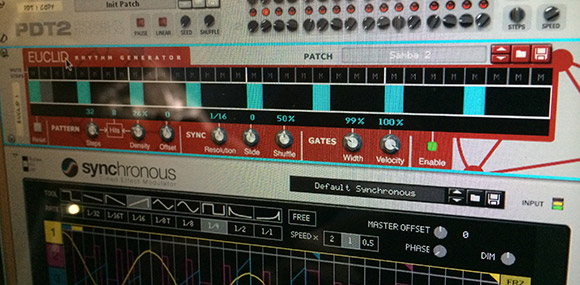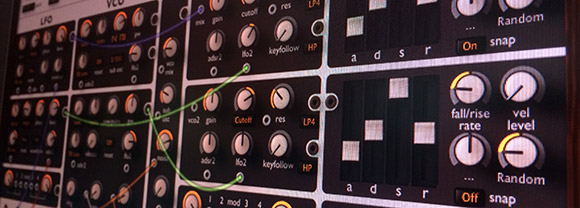The Virtues of Virtual
Posted: October 2nd, 2016 | Author: Nathan | Filed under: music, synthesis
Beelzebuzz on the bus!
I spend between two and three hours a day on a bus. I’m not proud. But one learns to adapt. And in that adaptation, surprising discoveries come about.
In my case, I rediscovered a love for an often-maligned audio application, and learned a ton about modular synthesis while riding over the Golden Gate Bridge ten times a week…one that ultimately led me to invest in modular synthesis hardware, which was the subject of my previous post. But if you’re curious about modular synthesis, for real, doing it in software first can be pretty darned smart. And cost-effective.
When I revised my studio hardware late last year, I decided that a MacBook Air would be a part of the mix. What a revelation that’s proved to be! So small, so light, and – even in its dinkiest incarnation – just as powerful as the older “proper” laptop it replaced. But as a guy who loves field recording, found sounds, and sound design, how could I use this tool on the bus creatively? Surely there must be a good way for me to spend time on my commute learning something. And I learn best through doing.
I explored what skills I could build on my bus ride to and from work, and decided two options existed: Learn more about music composition and theory, and learn synthesis at a seriously deep level. Being that the bus is a horrible listening environment, and I won’t ever be That Guy that brings a keyboard controller on his commute, I opted for the latter.
I forgot that I had a working, real license of Propellerheads Reason, sitting uninstalled. So I installed it on the MacBook Air and decided to set a few goals for myself.
- No playing through the MIDI keyboard, and no MIDI notes entered on a piano roll. All sequenced as if on a modular synth.
- No presets, ever. Clear all the settings (or find the most raw one) and always start with that.
- Don’t stop until you can create at least the standard drum sounds, bass, leads, and pads using subtractive synthesis.
- Don’t stop with just simple pure tones. Modulate everything so that it lives, breathes, and has some motion or unpredictability to it, even if it’s subtle.
I’ve become a solid user of analog synths over the years, but never directly set myself to learning them so deeply. Suddenly the “pre-wired” nature of Reason’s Subtractor synth became stifling, so I started using synths just for their filters or LFOs and patching them with other synths. Then I got a number of super-raw, purely modular Reason Rack Extensions from Ochen K. And then I started to get more parametric, procedural, and probabilistic sequencing Rack Extensions. My wallet was happy that I wasn’t buying modular synth hardware…but, of course, that came to a screeching halt.

Probability-driven drums, Euclidian synths, and waveform-controlled gates and velocities. Oh my.
Things got mathy quick. I have hours’ worth of glitching, burbling, super-weird virtual analog sounds and textures. If anyone ever needs alien telemetry sound effects, I’ve got a lifetime’s worth. (Pro tip: Throwing these aggressive textures into iZotope Iris is a whole other way to waste an entire day in sound heaven.)
But glitch, noise, and analog freakouts, my friends, are really relatively easy to do (and like many things, doing them extremely well is very labor intensive). Making melodic, rhythmic things in a modular way that don’t loop, per se, but yet still hold together over time…that’s even trickier. Focusing on that process really filled in my gaps in my synthesis knowledge. My main workflow now is sketching on the bus, tone sculpting once I’m in a better listening environment, and then rendering out stems of performances or patches for further work in a more traditional DAW. There, I often find that using a subtle tape saturation effect and physically-modeled compressor plugins can help bring in some of those overtones that analog gear is so renowned for.

Surprisingly few pro applications and virtual instruments offer the patching options of Reason and its modules. Here, U-He’s ACE semi-modular virtual synth bucks that trend. Madrona Labs’ Aalto is also superb.
And yet there, back in my powerful traditional DAW, I find myself missing all those little CV ports in Reason, allowing me to modulate anything with anything. Why can’t I take the pitch CV of a synth plugin and use it to modify a delay time parameter? Or use a buffer override or stutter plugin to retrigger an envelope generator? You can simulate these things with MIDI processors but it’s just not the same.
Suddenly my little MacBook Air feels like the world’s smallest, lightest, and maybe cheapest modular synth around. (Note that I didn’t say “best.”) If any readers are considering building a modular synthesizer, you could do a lot worse than learning your way around modular synthesis with Reason…since it costs the less than many single Eurorack synth modules.
Today’s sound combines edits of live programming and performance with machine-driven sequences, all centered around things made on my commute. What parts of your day could be more effectively used for focusing on creative pursuits?
[soundcloud url=”https://api.soundcloud.com/tracks/214330829″ params=”color=ff5500&auto_play=false&hide_related=false&show_comments=true&show_user=true&show_reposts=false” width=”100%” height=”166″ iframe=”true” /]
| No Comments »
Leave a Reply